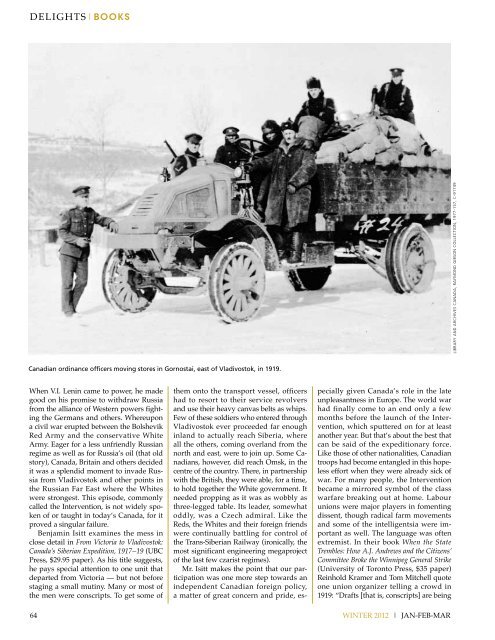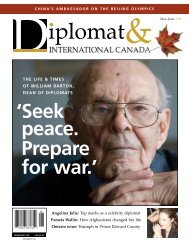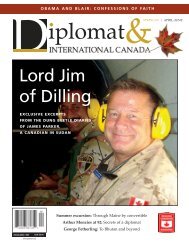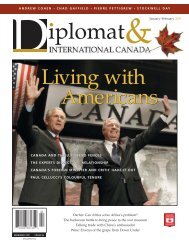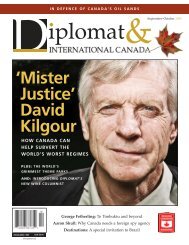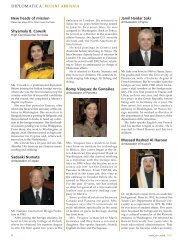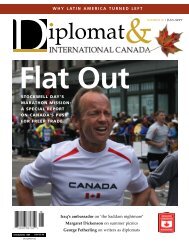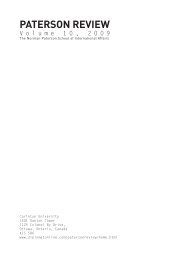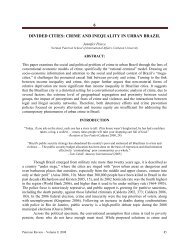John Baird: Canada's freedom agenda - Diplomat Magazine
John Baird: Canada's freedom agenda - Diplomat Magazine
John Baird: Canada's freedom agenda - Diplomat Magazine
Create successful ePaper yourself
Turn your PDF publications into a flip-book with our unique Google optimized e-Paper software.
Library and Archives Canada, Raymond Gibson Collection, 1977-157, C-91749DELIGHTS|BOOKSCanadian ordinance officers moving stores in Gornostai, east of Vladivostok, in 1919.When V.I. Lenin came to power, he madegood on his promise to withdraw Russiafrom the alliance of Western powers fightingthe Germans and others. Whereupona civil war erupted between the BolshevikRed Army and the conservative WhiteArmy. Eager for a less unfriendly Russianregime as well as for Russia’s oil (that oldstory), Canada, Britain and others decidedit was a splendid moment to invade Russiafrom Vladivostok and other points inthe Russian Far East where the Whiteswere strongest. This episode, commonlycalled the Intervention, is not widely spokenof or taught in today’s Canada, for itproved a singular failure.Benjamin Isitt examines the mess inclose detail in From Victoria to Vladivostok:Canada’s Siberian Expedition, 1917−19 (UBCPress, $29.95 paper). As his title suggests,he pays special attention to one unit thatdeparted from Victoria — but not beforestaging a small mutiny. Many or most ofthe men were conscripts. To get some of64them onto the transport vessel, officershad to resort to their service revolversand use their heavy canvas belts as whips.Few of these soldiers who entered throughVladivostok ever proceeded far enoughinland to actually reach Siberia, whereall the others, coming overland from thenorth and east, were to join up. Some Canadians,however, did reach Omsk, in thecentre of the country. There, in partnershipwith the British, they were able, for a time,to hold together the White government. Itneeded propping as it was as wobbly asthree-legged table. Its leader, somewhatoddly, was a Czech admiral. Like theReds, the Whites and their foreign friendswere continually battling for control ofthe Trans-Siberian Railway (ironically, themost significant engineering megaprojectof the last few czarist regimes).Mr. Isitt makes the point that our participationwas one more step towards anindependent Canadian foreign policy,a matter of great concern and pride, especiallygiven Canada’s role in the lateunpleasantness in Europe. The world warhad finally come to an end only a fewmonths before the launch of the Intervention,which sputtered on for at leastanother year. But that’s about the best thatcan be said of the expeditionary force.Like those of other nationalities, Canadiantroops had become entangled in this hopelesseffort when they were already sick ofwar. For many people, the Interventionbecame a mirrored symbol of the classwarfare breaking out at home. Labourunions were major players in fomentingdissent, though radical farm movementsand some of the intelligentsia were importantas well. The language was oftenextremist. In their book When the StateTrembles: How A.J. Andrews and the Citizens’Committee Broke the Winnipeg General Strike(University of Toronto Press, $35 paper)Reinhold Kramer and Tom Mitchell quoteone union organizer telling a crowd in1919: “Drafts [that is, conscripts] are beingWINTER 2012 | JAN-FEB-MAR


